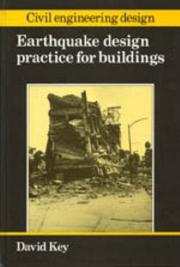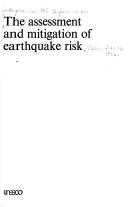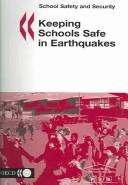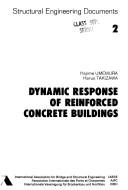| Listing 1 - 9 of 9 |
Sort by
|

ISBN: 0727713159 9780727713155 Year: 1988 Publisher: London: Telford,
Abstract | Keywords | Export | Availability | Bookmark
 Loading...
Loading...Choose an application
- Reference Manager
- EndNote
- RefWorks (Direct export to RefWorks)
Earthquake resistant design. --- Buildings --- Earthquake effects. --- Buildings - Earthquake effects.

ISBN: 923101451X Year: 1978 Publisher: Paris : Unesco
Abstract | Keywords | Export | Availability | Bookmark
 Loading...
Loading...Choose an application
- Reference Manager
- EndNote
- RefWorks (Direct export to RefWorks)
Buildings --- Earthquake hazard analysis --- Earthquake effects --- Congresses. --- Earthquake hazard analysis Congresses. --- Buildings Earthquake effects Congresses. --- Buildings Earthquake effects Congresses --- Earthquake hazard analysis Congresses --- Edifices --- Halls --- Structures --- Architecture --- Earthquake effects&delete& --- Congresses --- Built environment
Book
ISBN: 060793624X 9780607936247 Year: 2000 Volume: 1193 Publisher: Denver US. Geological survey
Abstract | Keywords | Export | Availability | Bookmark
 Loading...
Loading...Choose an application
- Reference Manager
- EndNote
- RefWorks (Direct export to RefWorks)

ISBN: 1280171693 9786610171699 9264016708 9264016694 Year: 2004 Publisher: Paris : OECD Publishing,
Abstract | Keywords | Export | Availability | Bookmark
 Loading...
Loading...Choose an application
- Reference Manager
- EndNote
- RefWorks (Direct export to RefWorks)
Earthquake-prone communities need earthquake-resistant schools. In 2002, a primary school in San Giuliano, Italy, collapsed killing 29 children and one teacher. In May 2003, a medium-sized earthquake in the city of Bingöl, Turkey, caused the collapse of three new schools and a dormitory, killing many children as they slept. All too frequently, earthquakes cause the collapse of school buildings and the injury and death of staff and students. Further, when schools are closed because of earthquake damage, education is hampered, community life disrupted, and potential emergency shelters unavailable. Where school attendance is compulsory, communities have an obligation to provide a safe study and work environment. Why do schools collapse even during moderate earthquakes? Experts agree that many collapse due to avoidable errors in design and construction. Often, the needed technology is not applied and laws and regulations are not sufficiently enforced. Application of existing knowledge can significantly lower the seismic risk of schools and help prevent further injury and death of school occupants during earthquakes. Moreover, this can be accomplished at reasonable cost and within a reasonable period. Keeping Schools Safe in Earthquakes presents expert knowledge, opinions and experiences, and provides valuable insight into the scope of problems involved in protecting schools and their occupants. Its recommendations are a call to action to all governments in OECD and partner countries to help facilitate their implementation.
Earthquake resistant design -- Cross-cultural studies. --- Earthquake resistant design. --- School buildings -- Design and construction -- Cross-cultural studies. --- School buildings -- Design and construction. --- School buildings -- Earthquake effects -- Cross-cultural studies. --- School buildings -- Earthquake effects. --- School buildings --- Design and construction --- Buildings, School --- School architecture --- School-houses --- Schoolhouses --- Public buildings --- School facilities
Book
ISBN: 1299386091 0080949444 0323281869 1856175014 9781856175012 9781299386099 9780080949444 Year: 2009 Publisher: Oxford Butterworth-Heinemann
Abstract | Keywords | Export | Availability | Bookmark
 Loading...
Loading...Choose an application
- Reference Manager
- EndNote
- RefWorks (Direct export to RefWorks)
Earthquake engineering is the ultimate challenge for structural engineers. Even if natural phenomena involve great uncertainties, structural engineers need to design buildings, bridges, and dams capable of resisting the destructive forces produced by them. These disasters have created a new awareness about the disaster preparedness and mitigation. Before a building, utility system, or transportation structure is built, engineers spend a great deal of time analyzing those structures to make sure they will perform reliably under seismic and other loads. The purpose of this book is to provide str
Disaster relief. --- Earthquake engineering. --- Earthquake hazard analysis. --- Earthquakes -- Safety measures. --- Earthquakes. --- Historic buildings -- Earthquake effects. --- Earthquake engineering --- Earthquake resistant design --- Civil & Environmental Engineering --- Engineering & Applied Sciences --- Civil Engineering --- Earthquake resistant design. --- Aseismic design --- Seismic design --- Structural design --- Vertical evacuation structures
Book
ISBN: 9400714475 9400714483 Year: 2011 Publisher: Dordrecht : Springer Netherlands : Imprint: Springer,
Abstract | Keywords | Export | Availability | Bookmark
 Loading...
Loading...Choose an application
- Reference Manager
- EndNote
- RefWorks (Direct export to RefWorks)
Current knowledge and state-of-the-art developments in topics related to the seismic performance and risk assessment of different types of structures and building stock are addressed in the book, with emphasis on probabilistic methods. The first part addresses the global risk components, as well as seismic hazard and ground motions, whereas the second, more extensive part presents recent advances in methods and tools for the seismic performance and risk assessment of structures. The book contains examples of steel, masonry and reinforced concrete buildings, as well as some examples related to various types of infrastructure, such as bridges and concrete gravity dams. The book's aim is to make a contribution towards the mitigation of seismic risk by presenting advanced methods and tools which can be used to achieve well-informed decision-making, this being the key element for the future protection of the built environment against earthquakes. Audience: This book will be of interest to researchers, postgraduate students and practicing engineers working in the fields of natural hazards, earthquake, structural and geotechnical engineering, and computational mechanics, but it may also be attractive to other experts working in the fields related to social and economic impact of earthquakes.
Buildings -- Earthquake effects. --- Earthquake engineering. --- Earthquake hazard analysis. --- Earthquake resistant design. --- Earthquakes -- Safety measures. --- Emergency management. --- Structural dynamics. --- Earthquake engineering --- Earthquake resistant design --- Earthquake hazard analysis --- Buildings --- Civil & Environmental Engineering --- Engineering & Applied Sciences --- Civil Engineering --- Earthquake effects --- Earthquake effects. --- Earthquakes and building --- Aseismic design --- Seismic design --- Earth sciences. --- Natural disasters. --- Geotechnical engineering. --- Civil engineering. --- Earth Sciences. --- Geotechnical Engineering & Applied Earth Sciences. --- Civil Engineering. --- Natural Hazards. --- Civil engineering --- Engineering --- Engineering geology --- Shear walls --- Structural design --- Vertical evacuation structures --- Geology. --- Public works --- Geognosy --- Geoscience --- Earth sciences --- Natural history --- Natural calamities --- Disasters --- Engineering, Geotechnical --- Geotechnics --- Geotechnology
Book
ISBN: 140209194X 9786611920456 1281920452 1402091966 1402091931 Year: 2009 Publisher: Dordrecht, Netherlands ; Boston, Massachusetts : Kluwer Academic Publishers,
Abstract | Keywords | Export | Availability | Bookmark
 Loading...
Loading...Choose an application
- Reference Manager
- EndNote
- RefWorks (Direct export to RefWorks)
The current state-of-the-art allows seismologists to give statistical estimates of the probability of a large earthquake striking a given region, identifying the areas in which the seismic hazard is the highest. However, the usefulness of these estimates is limited, without information about local subsoil conditions and the vulnerability of buildings. Identifying the sites where a local ampli?cation of seismic shaking will occur, and identifying the buildings that will be the weakest under the seismic shaking is the only strategy that allows effective defence against earthquake damage at an affordable cost, by applying selective reinforcement only to the structures that need it. Unfortunately, too often the Earth’s surface acted as a divide between seism- ogists and engineers. Now it is becoming clear that the building behaviour largely depends on the seismic input and the buildings on their turn act as seismic sources, in an intricate interplay that non-linear phenomena make even more complex. These phenomena are often the cause of observed damage enhancement during past ear- quakes. While research may pursue complex models to fully understand soil dyn- ics under seismic loading, we need, at the same time, simple models valid on average, whose results can be easily transferred to end users without prohibitive expenditure. Very complex models require a large amount of data that can only be obtained at a very high cost or may be impossible to get at all.
Buildings -- Earthquake effects -- Congresses. --- Earthquake engineering -- Congresses. --- Earthquakes -- Safety measures -- Congresses. --- Seismology -- Research -- Congresses. --- Earthquake engineering --- Buildings --- Earthquakes --- Seismology --- Civil Engineering --- Civil & Environmental Engineering --- Engineering & Applied Sciences --- Earthquake effects --- Safety measures --- Research --- Vibration. --- Earthquake engineering. --- Earthquake hazard analysis. --- Earthquake hazard assessment --- Hazard analysis, Earthquake --- Seismic hazard analysis --- Seismic risk assessment --- Seismic vulnerability assessment --- Hazard analysis --- Earth sciences. --- Geotechnical engineering. --- Dynamical systems. --- Dynamics. --- Civil engineering. --- Earth Sciences. --- Geotechnical Engineering & Applied Earth Sciences. --- Civil Engineering. --- Vibration, Dynamical Systems, Control. --- Cycles --- Mechanics --- Sound --- Civil engineering --- Engineering --- Engineering geology --- Shear walls --- Public works --- Dynamical systems --- Kinetics --- Mathematics --- Mechanics, Analytic --- Force and energy --- Physics --- Statics --- Engineering, Geotechnical --- Geotechnics --- Geotechnology --- Seismography --- Geophysics --- Quakes (Earthquakes) --- Earth movements --- Natural disasters

ISBN: 3857480297 9783857480294 Year: 1982 Volume: 2 Publisher: Zürich International Association for Bridge and Structural Engineering
Abstract | Keywords | Export | Availability | Bookmark
 Loading...
Loading...Choose an application
- Reference Manager
- EndNote
- RefWorks (Direct export to RefWorks)
Reinforced concrete construction --- Earthquake effects --- -Structures in reinforced concrete. Ferro-concrete structures --- -Building dynamics --- Buildings --- Structural dynamics --- 624.012.45 --- 624.04 --- Concrete construction --- Building dynamics --- Dynamics, Structural --- Structural vibration --- Strains and stresses --- Structural analysis (Engineering) --- 624.04 Structural design. Graphical and analytical statics for investigation and calculation of structures --- Structural design. Graphical and analytical statics for investigation and calculation of structures --- 624.012.45 Structures in reinforced concrete. Ferro-concrete structures --- Structures in reinforced concrete. Ferro-concrete structures --- Earthquakes and building --- Structural dynamics. --- Reinforced concrete construction. --- Earthquake effects. --- Buildings - Earthquake effects
Book
ISBN: 9400730667 9048126800 9786612459450 1282459457 9048126819 Year: 2009 Publisher: Dordrecht : Springer Netherlands : Imprint: Springer,
Abstract | Keywords | Export | Availability | Bookmark
 Loading...
Loading...Choose an application
- Reference Manager
- EndNote
- RefWorks (Direct export to RefWorks)
Many more people are coming to live in earthquake-prone areas, especially urban ones. Many such areas contain low-rise, low-cost housing, while little money is available to retrofit the buildings to avoid total collapse and thus potentially save lives. The lack of money, especially in developing countries, is exacerbated by difficulties with administration, implementation and public awareness. The future of modern earthquake engineering will come to be dominated by new kinds of measuring technologies, new materials developed especially for low-rise, low-cost buildings, simpler and thus lower cost options for retrofitting, cost cutting and raising public awareness. The book covers all the areas involved in this complex issue, from the prevention of total building collapse, through improvement techniques, to legal, financial, taxation and social issues. The contributors have all made valuable contributions in their own particular fields; all of them are or have been closely involved with the issues that can arise in seismic zones in any country. The recent research results published here offer invaluable pointers to practicing engineers and administrators, as well as other scientists whose work involves saving the lives and property of the many millions of people who live and work in hazardous buildings.
Buildings --Earthquake effects. --- Earthquake engineering. --- Earthquake hazard analysis. --- Structural engineering. --- Earthquake engineering --- Earthquake hazard analysis --- Buildings --- Structural engineering --- Engineering - General --- Civil Engineering --- Civil & Environmental Engineering --- Engineering & Applied Sciences --- Earthquake effects --- Earthquake resistant design. --- Earthquakes --- Risk assessment. --- Quakes (Earthquakes) --- Aseismic design --- Seismic design --- Engineering. --- Earth sciences. --- Geotechnical engineering. --- Structural mechanics. --- Vibration. --- Dynamical systems. --- Dynamics. --- Building. --- Construction. --- Engineering, Architectural. --- Building materials. --- Building Construction. --- Geotechnical Engineering & Applied Earth Sciences. --- Structural Mechanics. --- Earth Sciences, general. --- Vibration, Dynamical Systems, Control. --- Building Materials. --- Design and construction. --- Earth movements --- Natural disasters --- Seismology --- Structural design --- Vertical evacuation structures --- Mechanics. --- Mechanics, Applied. --- Geography. --- Building construction. --- Building Construction and Design. --- Solid Mechanics. --- Cycles --- Mechanics --- Sound --- Cosmography --- Earth sciences --- World history --- Applied mechanics --- Engineering, Mechanical --- Engineering mathematics --- Classical mechanics --- Newtonian mechanics --- Physics --- Dynamics --- Quantum theory --- Buildings—Design and construction. --- Dynamical systems --- Kinetics --- Mathematics --- Mechanics, Analytic --- Force and energy --- Statics --- Engineering, Geotechnical --- Geotechnics --- Geotechnology --- Engineering geology --- Geosciences --- Environmental sciences --- Physical sciences --- Architectural engineering --- Construction --- Construction science --- Engineering, Architectural --- Architecture --- Construction industry --- Architectural materials --- Building --- Building supplies --- Construction materials --- Structural materials --- Materials --- Design and construction
| Listing 1 - 9 of 9 |
Sort by
|

 Search
Search Feedback
Feedback About
About Help
Help News
News